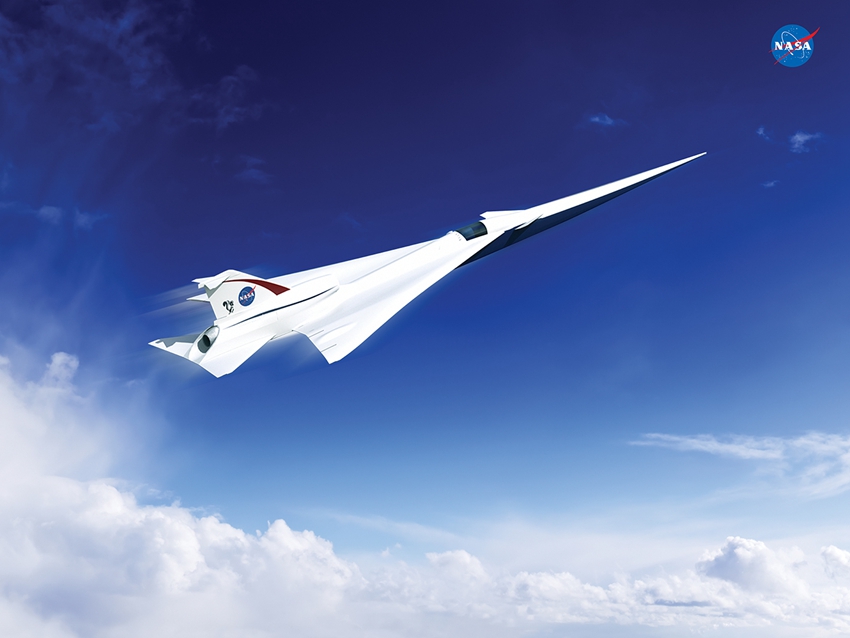 图为低音爆飞行演示中的静音超音速运输(QueSST)X-plane机型一种可能的设计方案。赢得超音速飞机的初步设计合同,仅仅是超音速客机回归的第一步,不过即使超音速飞机真的能够回归,回归后的机型也将更安静,成本也将更低。(洛克希德·马丁)
图为低音爆飞行演示中的静音超音速运输(QueSST)X-plane机型一种可能的设计方案。赢得超音速飞机的初步设计合同,仅仅是超音速客机回归的第一步,不过即使超音速飞机真的能够回归,回归后的机型也将更安静,成本也将更低。(洛克希德·马丁) 项目预算的要求是打造一系列X-plane,飞机必须使用清洁能源,并做到油耗减半、噪声减半。此外,打造世界上第一款“安静”的超音速X-plane也在该项目的预算要求之内。(美国宇航局/Lillian Gipson)
项目预算的要求是打造一系列X-plane,飞机必须使用清洁能源,并做到油耗减半、噪声减半。此外,打造世界上第一款“安静”的超音速X-plane也在该项目的预算要求之内。(美国宇航局/Lillian Gipson) 这种桁架支撑(truss-braced)机翼概念,可能属于另一款亚音速X-plane。风洞测试显示,与高级的传统机翼相比,这种新型机翼概念能将飞机的油耗降低5%到10%。(美国宇航局兰利研究中心/Sandie Gibbs)
这种桁架支撑(truss-braced)机翼概念,可能属于另一款亚音速X-plane。风洞测试显示,与高级的传统机翼相比,这种新型机翼概念能将飞机的油耗降低5%到10%。(美国宇航局兰利研究中心/Sandie Gibbs)
近日,超音速飞行的相关研究文件已经在不知不觉间堆满了各个工程研究工作站的桌面,静待美国宇航局(NASA)的审阅,从而选出一种最好的初步方案,以设计低音爆超音速飞行演示机。据了解,美国宇航局在2017财年预算中加入了一项名为新航空地平线(New Aviation Horizons)的倡议,计划推出了一系列X-plane机型,这驾超音速演示机就是其中的第一架。
“美国航空航天局正在努力提升飞机的飞行速度,同时让飞机更环保、更安全、更安静,并且还在构建一个运行更加高效的航空系统。”美国宇航局局长Charles Bolden日前表示,“值得注意的是,如今距离美国王牌飞行员Chuck Yeager驾驶一架贝尔X-1(Bell X-1)试验机首次冲破音障(sound barrier),已经过去了近70年。现在,我们将延续超音速X-plane的传奇,推出一架更加安静的超音速喷气式客运飞机。”
为了实现这一目标,美国宇航局精心挑选了一组由洛克希德·马丁航空公司(Lockheed Martin Aeronauics)带领的研发团队,完成静音超音速运输(QueSST)系统的初步设计。这项工作将在美国宇航局位于弗吉尼亚州的兰利研究中心(Langley Research Center)进行,属于该中心的基础与应用航空航天研究技术项目(Basic and Applied Aerospace Research and Technology)。
在真正推出商业化超音速飞机之前,美国宇航局进行了一系列灵活性研究,从而更好地了解全美各地对飞行噪声的接受程度。然后,宇航局要求航空业提交能够实现超音速飞行的试验机设计概念,但这种飞机必须满足宇航局提出的“超音速心跳”噪声控制要求,也就是说新的超音速飞机的噪声不能超过“心跳般”的轻轻撞击声,而不能像过去那样轰轰作响,震得房屋窗户也会跟着晃动。
洛克希德·马丁公司将在未来超过17个月内获得约2000万美金的经费,进行QueSST项目的初步设计。GE航空集团(GE Aviation)和Tri Models公司也是团队成员,将负责按照规格开发基础飞机需求、完成初步飞机设计,并提供有关概念成型与规划的配套文档。这些文档将用于准备QueSST喷气机的详细设计、实际建造和后续测试。此外,初步设计的飞机性能也必须经过分析验证和风洞测试验证。
洛克希德公司并不是最近才开始进行超音速飞行研究,几年前该公司就曾服务于美国宇航局的N+2项目。洛克希德·马丁公司N+2项目经理Micheal Buonanno表示,那时我们并不是仅“开发了一个全新的推进系统”,而且还探索了多种新技术的应用,包括“低噪声飞机排气系统、集成风扇噪声抑制系统、机体噪声抑制系统,以及计算机定制机场噪声消减系统。”
正是由于Buonanno的团队“成功开发了一套工具和代码,如今工程师和设计师才能准确地预测飞机的音爆水平。”
该项目在初期的低音爆飞行演示(Low Boom Flight Demonstration)阶段,还将验证社区将对这种更加安静的超音速设计作何反应。未来,QueSST飞机的详细设计与建造将通过合同竞标方式,选择最合适的公司完成。
美国宇航局的“新航空地平线项目”为期10年,主要围绕在通过与传统飞机“机身加机翼(tube-and-wing)”形态不同的创新飞机设计,减少燃料使用、实现减排目标,并降低飞机噪声。该项目打造的X-plane通常仅有量产机型一半的尺寸,很有可能可以驾驶。据了解,飞机的设计与建造工作将花费数年时间,可能将于2020年左右开始进行飞行活动,具体时间将主要取决于经费情况。
作者:Jean L. Broge
来源:SAE《航空航天工程》杂志
翻译:SAE 上海办公室
NASA takes a respectable-sized step toward supersonic flight
Research on supersonic flight has quietly been infiltrating the desks of a variety of engineering work stations, verified by NASA's recent contract award for the preliminary design of a flight demonstration aircraft with a low boom profile. This is the first in a series of X-planes in NASA's New Aviation Horizons initiative, introduced in the agency’s Fiscal Year 2017 budget.
“NASA is working hard to make flight greener, safer, and quieter—all while developing aircraft that travel faster, and building an aviation system that operates more efficiently,” NASA Administrator Charles Bolden said recently. “It’s worth noting that it's been almost 70 years since Chuck Yeager broke the sound barrier in the Bell X-1. Now we’re continuing that supersonic X-plane legacy with this preliminary design award for a quieter supersonic jet with an aim toward passenger flight."
To that end, NASA selected a team led by Lockheed Martin Aeronautics to complete a preliminary design for Quiet Supersonic Technology (QueSST). The work will be conducted under a task order against the Basic and Applied Aerospace Research and Technology (BAART) contract at NASA's Langley Research Center in Virginia.
Prior to going out to industry, NASA conducted feasibility studies to better understand acceptable sound levels across the country. It then asked industry teams to submit design concepts for a piloted test aircraft that can fly at supersonic speeds, creating what it describes as a "supersonic heartbeat"—a soft thump rather than the window-shaking boom most often associated with supersonic flight.
Lockheed Martin will receive about $20 million over 17 months for QueSST preliminary design work. GE Aviation and Tri Models are also part of the team, which will develop baseline aircraft requirements and a preliminary aircraft design, with specifications, and provide supporting documentation for concept formulation and planning. This documentation will be used to prepare for the detailed design, building, and testing of the QueSST jet. Performance of the preliminary design also must undergo analytical and wind tunnel validation.
Lockheed is not a newcomer to the study of supersonic flight, having worked on the NASA N+2 program some years ago. In that concept not only was a "totally new kind of propulsion system developed," but the company also explored "new techniques for low noise jet exhaust, integrated fan noise suppression, airframe noise suppression, and computer customized airport noise abatement," according to Micheal Buonanno, Lockheed Martin's Manager of that N+2 program.
It was his team that developed the "tools and codes that allow engineers and designers to accurately predict the loudness of a plane's sonic boom."
This initial Low Boom Flight Demonstration phase of the project also will include validation of community response to the new, quieter supersonic design. The detailed design and building of the QueSST aircraft will fall under a future contract competition.
NASA’s 10-year New Aviation Horizons initiative is built around reducing fuel use, emissions, and noise through innovations in aircraft design that departs from the conventional tube-and-wing aircraft shape. The X-planes that come out of the initiative will typically be about half-scale of a production aircraft and likely are to be piloted. Design-and-build will take several years with aircraft starting their flight campaign around 2020, depending on funding.
Author: Jean L. Broge
Source: SAE Aerospace Engineering Magazine
等级
打分
- 2分
- 4分
- 6分
- 8分
- 10分
平均分
